#vaccine site sarcoma
Text
Biotech Breakthroughs in 2018
The biotech field is in a constant state of evolution, and gene editing has become one of the most promising technologies. It's the ability to alter DNA at specific sites in the genome with precision, potentially deleting or inserting a new gene to treat a disease. The most common methods of genome editing utilize engineered nucleases that act as molecular scissors, which target specific regions of the DNA and induce double-strand breaks at those sites. These are then repaired through non-homologous end joining or homologous recombination, creating targeted mutations ('edits').
This technology holds great promise in areas such as synthetic biology, human gene therapy, disease modeling, drug discovery and neuroscience, but it also raises a number of ethical questions about what it could mean to use this technology in germline gene modification. Some fear that, if used widely enough, genome editing could lead to classes of individuals defined by their engineered genes and could potentially open the door for designer babies.

Genetic diseases, including many types of cancer, are often caused by a single faulty gene. The idea that a single gene or group of genes might cause disease has been around since the 1950s, when scientists first recognized that techogle.co DNA is passed faithfully from parent to child, carrying the blueprint for life's physical and behavioral characteristics.
In 2018, the development of genome editing has made it possible to identify and replace a defective gene to prevent or cure disease. Scientists can use this technique to identify and replace the genes responsible for a variety of diseases, including Alzheimer's disease, Parkinson's disease, cancer, and rare disorders.
Scientists develop protocols to sequence long sections of DNA, and researchers clone the gene for a protein that controls the activity of insulin-producing cells in bacteria. This enables the production of the first genetically engineered insulin.
The first gene-based pharmaceuticals are developed, including a monoclonal antibody to fight kidney transplant rejection and a vaccine for hepatitis B. A new class of drugs, called interferons, are created to prevent a complication of AIDS, Kaposi's sarcoma.
Biotech advances make it easier to collect and analyze data from clinical trials, speeding up the drug-development process and helping doctors better determine a patient's underlying condition. These advancements have made it possible for more patients to enroll in clinical trials and help improve the effectiveness of treatments.
When asked about the impact technology news of gene editing on society, Americans are mixed on its potential benefits and risks. Some 39% think widespread use of gene editing would greatly reduce a baby's risk of developing serious disease over their lifetime, while 55% say it would only have an average or smaller effect. In addition, 39% say it would increase the gap between higher- and lower-income people, while 27% think it would decrease the gap.
1 note
·
View note
Photo
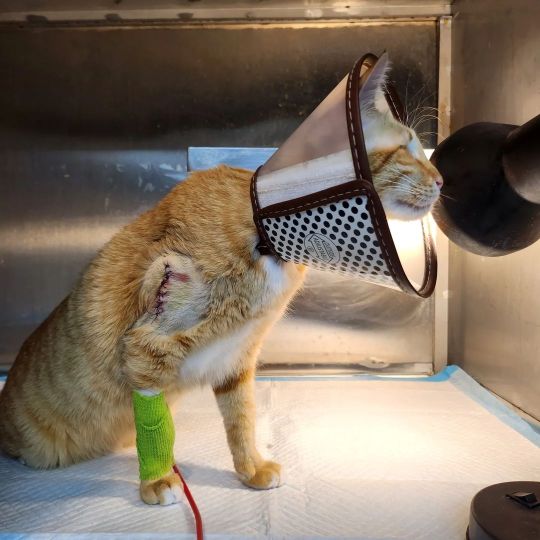
Day 023-2023: Heartbreaking to come home to this. 😿 Last Friday, we noticed a lump on her right shoulder where she often gets injected with vaccines. Apparently, injections, especially from anti-rabies vaccines, can cause tumors. "Injection site sarcomas arise at sites where the cat previously received an injection. Tumors are caused by vaccines (feline leukemia virus and rabies vaccines), microchips, injections of long-acting antibiotics, long-acting glucocorticoids, lufenuron, and reaction to nonabsorbable suture." We had to make a quick decision for Echo lest the tumor is malignant and it spreads to her legs which could result in amputating her leg. She had surgery done today to remove the tumor which, fortunately, was only skin-deep and did not reach her muscles. It is for biopsy and we are hoping that it turns out benign. This is another lesson learned for us as fur-parents. Our advice to other fur-parents is to check with their vets and set just the right frequency of having vsccine shots. We were just following the mandated annual vaccination, but apparently, there are anti-rabies vaccines that are good for 3 years. Thank you @thecatclinicph and Doc @marionalyanna for taking good care of Echo! Be well Echo. Stitch misses you. We miss you! #Life365 (at The Cat Clinic) https://www.instagram.com/p/CnwlsR0pNao/?igshid=NGJjMDIxMWI=
0 notes
Text
https://www.youtube.com/embed/CciqK4W7Iyg
Should You Adopt a Bengal Cat
If you are considering adopting a Bengal cat, you should know the requirements before making a decision. You should make sure that you can provide the right kind of equipment for your new pet. If you are unable to provide this, you should consider another option. Vaccinations, cost, and coat colors are also important factors that you must take into consideration.
Beware of pet sales scams
Bengal cats are popular pets, but they can also be a target for scams. These scams can range from simple to complex, and they can be frustrating for both new Bengal owners and legitimate breeders. Thankfully, there are ways to protect yourself from being a victim. The first step is to be aware of common red flags. Some scams involve "free-to-good-home" offers, where the breeder fails to disclose a large delivery or shipping fee. In addition, scammers may ask you to pay through Western Union or other third party intermediaries.
Many scammers create custom websites or advertise on classified ads to lure potential victims. They will also attempt to gain a deep emotional attachment from their intended victims. People who are emotionally attached are more susceptible to being scammed, and scammers know this. Beware of scammers who use the names of legitimate pet shippers and use websites that use pirated content and logos.
Scammers will use social media sites to entice buyers to make a large deposit without even seeing the pet in person. They will also create an air of urgency by asking for a deposit upfront. The sellers may even ask you to make the deposit before the kitten is even delivered to you.
Be sure to ask if the kitten has been screened for diseases before purchasing it. Some breeders do not require this. The kittens should be at least twelve weeks old to be fully vaccinated and dewormed. This helps them handle the stress of moving into their new home and family. A breeder who offers a Bengal kitten that is younger than that will be more likely to be in a hurry to collect payment and not care about the kittens' health.
Vaccinations
Vaccinations for Bengal cats are an essential part of Bengal cat health care. These vaccinations are made of modified viruses that help build your kitten's immunity and protect it from disease. Most vaccines are given to kittens between three to 12 weeks of age and protect them against common and sometimes fatal diseases.
Vaccinations for Bengal cats
There are risks associated with vaccines, but they are generally very mild. Side effects include lethargy, transient fever, and local inflammation. Anaphylaxis, or an allergic reaction, is rare. In rare cases, cats may develop vaccine-associated sarcoma, a slow-growing tumor that develops around the injection site.
Vaccinations for Bengal cats protect your pet from rabies and feline leukemia. Rabies is a disease caused by bullet-shaped Rhabdovirus that is spread through biting. The virus travels to the central nervous system and attacks the brain of its host. When the virus infects the central nervous system, the immune system cannot respond to the infection.
Vaccinations for Bengal cats are recommended as early as six weeks of age. However, if a kitten is vaccinated too early, it can pose a risk to the kitten's health. A kitten's immune system is not fully developed at birth, so vaccination is important for its protection. The vaccines are given to kittens over a period of 12 to 16 weeks. This allows them to absorb antibodies from their mother and protect them from infection.
While vaccinations for Bengal cats are very important, they are not necessary for all Bengal cats. There are several vaccines available for these cats, including the FeLV vaccine. The FeLV vaccine protects cats against the feline leukemia virus, which is present throughout the world. It is transmitted from cat to cat by saliva, urine, and milk. Infected cats typically die within two and a half years.
Cost
The cost of adopting a Bengal cat varies depending on the location. In some cases, you may be able to save money by getting the pet from a friend or neighbor who is able to watch it for free. Other times, you may need to pay a boarding facility for your Bengal cat. A cat boarding facility may cost up to $40 per night. Other services like pet sitters can charge as little as $15 per night. You will also need to pay a pet deposit fee which covers any damage the Bengal cat may cause. This fee may be from $30 to $100 per month.
When purchasing a Bengal cat from a breeder, the price is usually much higher than the price of a cat adopted from a rescue. Depending on the breeder, an adult Bengal cat can cost anywhere from $1,500 to $3,000. A Bengal kitten can cost anywhere from $1,500 to $2,500. This price can be higher if the kitten is show-quality, but a cat that isn't show-quality will be cheaper.
Bengal cats are intelligent and large-sized. Depending on the location and the style of cat care you choose, your costs will vary. The adoption fee will vary depending on your chosen care style and the city in which you live. It is important to note that there are many ways to reduce the cost of Bengal cats. While a low-cost adoption clinic can help with microchipping and vaccinations, it will not cover emergency care and cat toys. If you cannot afford expensive cat toys, consider making do with cardboard boxes or cat trees.
Another consideration in adoption is the age of the kitten. A kitten that is two years old or older may be more difficult to integrate into a new home. It may have special needs, and you may need to have experience with correcting bad cat behavior. However, older cats can also be a rewarding experience for the right person.
Coat colors
Bengal cats have different coat colors. While the short-haired Bengal is the most common, there are some different color combinations. The color of these cats is dependent on the genes used to produce them. Some Bengals have more red pigment than others, while others have more orange or brown. If you are looking for a Bengal with a particular color, read on to learn more about what you can expect from your new pet.
The most common color of Bengal cats is brown, and while this is often what we picture of this cat, the range of color is extensive. In fact, some Bengals are even reddish or caramel in color. This makes it possible to select any color for your Bengal cat's coat! You can also choose from different eye colors.
In addition to coat colors, Bengals also have different markings. They can have rosettes or marbling. Rosettes are a distinctive pattern that resembles leopard markings, while marbling is a more abstract and blotchy pattern. Both are a part of the tabby family, and are often accompanied by a tabby 'M' on the forehead.
A Bengal cat's coat can be brown, orange-gold, or silver, but the most common color is brown. The Bengal color family also includes the rare Blue Bengal. These cats are the rarest and most beautiful of all the Bengal breeds. At birth, they look like normal Bengals without any patterns. Their coat colors can be spotted with black spots or white, or with a gray background.
Some Bengals have marbled coats. Marbled cats have a high ratio of patterns compared to the background color. These cats may take two years to open up their marbled coats, but once they have done so, they can reveal a unique pattern.
Care
If you are considering adopting a Bengal cat, you need to know how to care for them properly. They are highly social pets that enjoy interacting with humans. Since they have high energy levels, you'll want to make sure they have plenty of activities to burn off excess energy. Bengal kittens are no exception, and they love to play for hours.
considering adopting a Bengal cat
Like any other type of cat, Bengals need routine health care. That means vaccinations, deworming, neutering, and microchipping. The microchip helps keep your pet's owner's identity safe.
Unfortunately, not all veterinarians specialize in Bengal cats. For this reason, it's important to find a Bengal cat vet who can provide routine care.
Bengal cats are highly intelligent and playful. They enjoy jumping and climbing and playing fetch. They also enjoy long walks. They also need lots of attention, but they can handle some alone time. Bengal cats are great family pets. They learn tricks easily and can be trained to play fetch. They also like to swim in water.
Bengal cats should be vaccinated and dewormed for common illnesses. They can develop hypertrophic cardiomyopathy, which requires an echocardiogram scan of the heart. Also, they can develop a range of hormone disorders, including cancer. It's important to know whether a breeder's cats have tested negative for these diseases.
Bengal cats are very active and social. They love to be around people, and are very playful. However, they can be destructive if left alone for long periods. They are prone to opening cabinets and drawers, or even tearing things apart. Bengals are also known for being incredibly stubborn, so they may deliberately do things that attract attention or take things away from their owners. But they are very responsive to training and can learn new tricks with clicker training. Interactive toys are also a great way to keep them entertained.
0 notes
Text
What Vaccines Do Cats REQUIRE A Guide to Picture for Cats
When it concerns shots for cats, cat moms and dads have lots of inquiries. What injections do pet cats require? Just how often should cats obtain photos? Are we under-vaccinating or over-vaccinating our pet cats?
What injections do cats require? Lots of cat caretakers have very highly held ideas associated with vaccinations. So it is not shocking that vaccinations in human health and wellness attended to be questionable. Which dispute has clawed its method in to the realm of feline health and fitness?
What vaccines do cats need? Are we under-vaccinating or over-vaccinating our pet cats?
When investigating this post, I did not talk with experts with all feasible viewpoints, of which there are several about vaccines, or I possibly could have authored a publication. I talked with leaders with apparent proficiency, which helped craft the American Organization of Feline Practitioners' (AAFP) Standards for Vaccinations.
Love or hate vaccinations, it's a truth: Vaccination plays a vital function in controlling infectious conditions, both for a person and the feline population most importantly (called herd health and wellness). Every many years, feline specialists integrated to upgrade the AAFP injection guidelines. One of the most current panels, in 2013, was chaired by Dr. Margie Scherk, editor of the Journal of Feline Medicine and Surgical Treatment.
After evaluating literature relating to feline vaccinations, Dr. Scherk comes down with a significantly different conclusion than some feline caretakers contend. She claims, "We're not over-vaccinating; we're under-vaccinating pet cats."
She describes that, for starters, too many cats never visit a veterinarian until that specific pet cat is ill. Undoubtedly, if the cat isn't seeing a veterinarian, the cat isn't obtaining vaccinated. Issues of some feline caretakers certainly are a barricade: concerning the need for specific vaccines, their feline is being immunized frequently, problems concerning shot site sarcoma (cancer at the positioning of the vaccination), and in addition, occasionally, the vaccination expense.
" Because they're not seeing a vet, I locate that some individuals are simply uninformed of what vaccines are essential," adds Shila Nordone, Ph.D., immediate previous president of the Winn Feline Foundation board of supervisors and Supervisor of Research Study Development, Duke College Nicholas College of the surroundings. Also contained in the standards are referrals for neighborhood cats, not just a concern in the dog globe. "Naturally, we considered all pet cats, and that is as it should be," Dr. Scherck states.
What injections do felines need? The distinctions between core and also noncore vaccines.
AAFP provides two injection groups: Core and Noncore.
1. Core injections are those advised for several pet cats. The AAFP Advisory Panel recommends that the next come under this classification:
Feline panleukopenia (FPV).
Feline herpesvirus-1 (FHV-1)
Feline calicivirus (FCV)
2. Noncore vaccinations should be administered to cats in specific danger groups predicated on a particular risk/benefit analysis, based on:
The private feline's way of living
The pet cat caretakers' lifestyle (do the caretakers absorb foster or roaming cats?)
3. Location. The Advisory Panel believes that complying with injections belong to this classification:
Rabies.
Feline leukemia virus (FeLV)
Chlamydophila felis
Bordetella bronchiseptica
Feline infectious peritonitis (FIP)
Dermatophyte injection
Should rabies be a core cat injection?
Both interior and also exterior pet cats, like area pet cats (right), come in danger for rabies, as they can enter call with rabies providers, like bats.
Both indoor and exterior felines, like community felines (right), head to danger for rabies, because they can enter call with rabies' providers, like bats.
Nonetheless, not everyone agrees. Dr. Donna Alexander, manager of Cook County (which includes Chicago) Pet and Rabies Control, states that rabies vaccinations for felines ought to be taken into consideration core in the same way they're for canines. "Rabies has got to be the core for cats," states Dr. Richard Ford, emeritus professor of medication, North Carolina State College. And over half the states need rabies vaccines for pet cats by legislation.
" Lots of people think their felines are purely indoors and in addition never can be revealed," Dr. Alexander includes. "That is clearly a misconception. We have bats discovered in houses. Plenty of those individuals have felines, and the ones pet cats don't go out. They find the bat and also deliver the dead or nearly dead bat to members of the family because they would a mouse."
Likewise, primarily many or exclusively outside felines may not be immunized whatsoever, together with they have a possibly high direct contact with skunks, raccoons, along with other wildlife, which might carry rabies.
Using the CDC referral, if an unvaccinated pet cat enters into contact with any animal believed to be rabid, that unvaccinated cat will undoubtedly be quarantined or euthanized.
" Vaccine-related reactions due to rabies vaccination are about one in a million along with tend not harmful," Dr. Alexander says. "Rabies kills 100 percent of the time. In addition to that, anybody revealed to a feline believed to have rabies needs painful and costly rabies desensitization themselves."
The CDC validates Dr. Alexander's comments, as felines are often more prone to be found with rabies contrasted to pet dogs. In 2015, 67 dogs were reported crazed contrasted to 244 pet cats.
Felines with high exposure are outdoors, just, or neighborhood cats. If pet cats are trapped, neutered, and returned (TNR), the AAFP panel recommends those pet cats get vaccines for feline panleukopenia (feline distemper), feline herpesvirus-1, feline calicivirus and also rabies.
" One dosage will likely inoculate pet cats longer than one year, yet lawfully if the feline does bite a person also a day beyond per year, that cat is not considered secured," adds Dr. Ford, that has been also on the AAFP vaccination guideline panel. "The bottom line: All cats should be vaccinated for rabies."
Exactly how commonly should we immunize pet cats?
When asking "What vaccines do pet cats need," "Just how commonly do pet cats require shots" is really a question some pet cat owners have that insists we're over-vaccinating.
" When it involves the duration of immunity, the rules are pretty strong, as we involve some rather strong studies," Dr. Nordone claims.
However, often there are no owners-- those will be the felines who land at pet shelters. Dr. Julie Levy, professor of shelter medication at the Maddie's Shelter Medication Program, College of the Florida University of Vet Medicine, Gainesville, likewise served on the AAFP Panel. "It's awarding that the distinct demands of shelters are shown in the Injection Guidelines," she claims. "A lot more felines are enduring shelters, and their wellness, and well-being, can be an investment worth making. We recognize that cats will be conserved whenever we immunize instantly. Felines are especially prone to tension and also illness in a shelter setting." Dr. Scherk adds, "Associated with feline leukemia, testing felines before vaccination is essential to make certain adverse status. Unintentional usage of FeLV vaccination in a cat infected with FeLV is not damaging. However, it really is additionally of no benefit.".
The AAFP Advisory Panel recommends carrying out FeLV vaccinations to all kitties yet takes into consideration the immunization to be noncore for cats after their one-year booster unless they're at threat of exposure since they have accessibility to outdoors, live with recognized FeLV-infected felines or reside in a multiple-cat environment where the status of most pet cats coming and going is probably not acknowledged.
Vaccination of most kitty cats is suggested just because a kitty cat's status (interior versus outdoor, the reduced risk versus great danger) might alter, and vulnerability to consistent infection is thought to be most significant in kittens. "We have now understand FeLV may essentially conceal in a cat unsafe from then on suddenly show up later on in life," Dr. Scherk says.
Without doubt, the foremost communicators to feline caretakers may be vet technicians or registered nurses at many vet practices. Julie Legrand is really a qualified professional and the executive director of the National Organization of Vet Service Technicians in America. "It's tough when a customer is persuaded of something, which we understand not to be real, based on scientific tests. We hope that clients develop trust that a lot of of us desire exactly the same point-- what's finest for that each feline.".
Dr. Nordone includes, "Significantly, we see individualized medication-- and many vaccination suggestions are without a doubt predicated on what's best for an individual.".
what smells do cats hate
0 notes
Note
I’ve heard a lot of people say that they refuse to vaccinate their cats because it will give them cancer (sarcomas?). Is that a real thing? When I google it is really hard to sort through what’s anti vax and what’s properly researched info.
gettingvetted here.
With standard rabies and feline leukemia vaccines (the two killed vaccines that are available for cats) there is a chance of vaccine site sarcoma. These cancers are extremely aggressive, grow very quickly, and tend to have "octopus tentacles" that reach farther and deeper than the main bulk of the tumor. It is extremely difficult to remove them because you have to remove them with a very wide margin which usually includes taking muscle or other tissue under the mass, and they are very likely to recur. This is why most vets today will vaccinate as far down on the limbs or even the tail as possible, because it is much easier to amputate a limb or tail than to remove such a large and aggressive tumor from between the shoulder blades (the previous favorite location for all vaccine injections).
However, the development of this cancer is a 1 in 10,000 lifetime chance. As a result, it is very hard to study these cancers in a controlled setting, because you would need to keep 10,000 cats for their entire lives, hoping to see one case of cancer. It is hypothesized that the adjuvants (additives/irritants) which are necessary to get the immune system to respond to a killed vaccine (why would the immune system react to something already dead?) are responsible for the cancers. For some reason, cats respond negatively to any kind of inflammation - resorbing their own teeth just because they have a little gingivitis, going into liver failure just because it was a little overworked when they didn't eat for a couple of days, and cancer at the site of certain vaccines. Today there are newer killed vaccines that use fewer adjuvants and different adjuvants than historical vaccines. Obviously since the risk was already extremely low, it is hard to track real-life instances and prevalence of this cancer. But, at this time, there are no recorded instances of vaccine site sarcoma if a cat has only had these modified vaccines during their lifetime.
Regardless of which vaccine is used, in the US it is legally required to have an up-to-date rabies vaccine in most states, and the risk of rabies (and feline leukemia in outdoor cats) is higher than the risk of cancer. Vaccine site sarcomas should not be a reason not to vaccinate, especially since we have safer alternative vaccines available.
**note - the FVRCP ("respiratory") vaccine for cats is a modified live vaccine which doesn't require significant adjuvants and vaccine site sarcomas have not been associated with this vaccine.
#anonymous#vaccinations#cat vaccinations#cat vaccines#feline vaccines#frvrcp#rabies#rabies vaccine#feline leukemia vaccine#adjuvants#vaccine site sarcoma
977 notes
·
View notes
Note
I just watched this video about a US veterinarian complaining about the rules of how rabies vaccines are administered. Essentially, the complaint was about how a 2.2kg dog receives the same dose as a 45kg dog, and that some dogs - I would assume it's the smaller dogs - are dying and seeing adverse effects because the dose is higher than they should be receiving. I'd never heard of this controversy and wondered if you had and your take on it. The video was of Dr. Jon Robb; I can't find the link.
Vaccinations are one of the most hotly debated topic in veterinarian medicine, not just by ‘natural’ websites but also by highly qualified veterinarians and immunologists which have dedicated their professional scientific careers to the topic and so actually know what they’re talking about.
So to have this discussion, I’m going to have to go over some of the basics of vaccines so we’re all on the same page. I also request that if you have something to contribute to the topic, you add it in a reply or reblog rather than submitting a separate ask, so the conversation can stay in one place. Otherwise readers get lost.
I actually attended an immunology conference in 2010, and most of its discussions was around vaccines. Over the week we attending veterinarians spent 38 hours discussing vaccines, schedules, reactions, complications and associated illnesses in depth, specialists and generalists alike. Then the last two hours were an open forum for questions which was attended by a member of the general public, who actually stood up and basically asked “What are vets doing about adverse vaccine reactions and why aren’t they doing more?”
It was very tempting to just point to the prior 38 hours that week we’d spent answering that question.
My point is that vaccines and immunology is not a quick or easy topic if you want to understand it and not just jump on a sensationalist bandwagon.
Why do all members of a species receive the same dose vaccine instead of a mg/kg dose like other drugs?
Most drugs are administered in a mg/kg manner, that is to say larger animals get a larger dose and smaller animals get a smaller dose.
This in itself isn’t even strictly true. To be most accurate, drugs should generally be calculates by a mg per surface area, but calculating surface area is a pain in the backside and so we generally only do it for drugs with an exceptionally narrow safe dose range, like chemotherapy. To make things faster, for most dogs we will use body weight to make our calculations, though some medications will have different dose rates for dogs above or below a certain size.
Vaccines and hormones don’t follow this rule. For these sorts of medications there’s not really a per bodyweight dose, just a threshold where the dose is ‘enough’. Double, triple or quadrupling a dose of oxytocin, for example, does not actually do anything once they’re reached that ‘enough’ point. Doubling a vaccine dose does not increase the protective immunity once the initial dose is ‘enough’.
This might seem counter-intuitive, especially when you look at the diversity of sizes in dogs. Surely a vaccine administered to a chihuahua will be more concentrated in its body than the same vaccine administered to a great dane? Well it probably is, but as long as we have an effective dose in both, it will still work.
What are adverse vaccine reactions and how do they relate to vaccine dose?
Vaccines actively stimulate the immune system, and like all medications in use everywhere (unlike homeopathy which is water and wishful thinking) they do things we want and things we don’t want. The things we don’t want are termed ‘adverse effects/reactions’, and they vary in their frequency and severity. They include:
fever (quiet or reduced appetite for 12-24 hours)
tenderness at injection site
anaphylaxis (swollen face and paws, like a bee sting reaction)
Immune mediated disease (eg IMHA)
Some cancers (sarcomas, specifically)
Death
But don’t panic!
Take a moment to consider the potential reactions on the list. Fever and tenderness is because the immune system is doing its thing, it’s responding (appropriately) to the vaccine. These adverse reactions are minor and often require no intervention at all, though some repeat offenders might get an antihistamine with their vaccines in the future. They are also both more likely in juvenile, small animals and so are potentially related to the dose of vaccine or adjuvant per kilogram body weight.
So if smaller animals are more likely to show tenderness and fever after a vaccine, which are indications that the body is responding, then they might still respond to a lower dose of vaccine.
More on that later.
Anaphylaxis and death are not dose or frequency dependent. They are an inappropriate response by the immune system, just like life threatening peanut allergies in humans. Because the immune response is blown so out of proportion, it doesn’t matter what the dose is, you will still get the reaction.
If a person with a peanut allergy eats a single peanut, the reaction is going to be the same as whether they ate a whole jar of peanut butter. Same with the vaccine. If it’s going to happen, it will.
This is independent of dose and completely unpredictable, but rare. Death is especially rare. Some brands of vaccine might seem more or less likely to cause anaphylactic reactions than others, but the jury is still out on this.
Immune mediated diseases and cancers are particularly interesting, and have grabbed a lot of attention from sensationalist media over the last decade. There are lots of different ones that might be associated with vaccines, but I’m going to focus on the most common two from each category because I don’t intend to lecture you for 38 hours.
Immune Mediated Haemolytic Anaemia (IMHA) Is a very interesting disease where the body attacks its own red blood cells, destroying them and causing anaemia. Some quick and dirty facts about IMHA:
33% of cases occur within 3 months of a vaccine
50% of cases also have some sort of cancer (Haemangiosarcoma (HSarc) being most common)
Approximately only 50% survive
If IMHA was completely independent of vaccination, and the dogs were all getting a vaccine once a year, you’d expect 25% of cases to occur within 3 months of a vaccine. 33% is a little suspicious. But we can’t blame vaccination for all cases of IMHA, not even close, with all those nasty HSarcs around, which on their own only have a survival rate of a few months.
In a nutshell, IMHA can be triggered by any immune system stimulation at all. For many dogs, vaccines will be the most common immune system stimulus they encounter, but cancers and viruses can do it as well. It’s not fair or accurate to blame vaccines for causing all IMHA, but we also can’t discount the possibility in an individual patient.
Injection site sarcomas (ISS) are the specific cancer associated with vaccines, especially in cats. This cancer is slow to spread but difficult to remove, and seems to be more associated with the rabies, FIV and FeLeuk vaccines more than others.
Again, however, it’s not just caused by vaccines. Any injection in a cat can trigger this type of neoplasia, and so can cat bite abscesses. It’s just that the vaccines are going to be the most common type of injection your typical cat gets.
In both IMHA and ISS, they’re basically just bad luck when they occur, but they will be independent of the dose. They’re either going to do the thing, or they wont.
So reducing the dose of a vaccine will probably not save any animal lives, but may reduce the adverse reactions that owners most frequently complain about (fever and tenderness). It might benefit the patients somewhat, but it is potentially blown a little out of proportion.
That said - I have never administered a rabies vaccine in my life. That’s a perk of living in Australia, we just don’t have it here. I don’t have boots-on-the-ground experience of that specific vaccine, so perhaps the frequency of adverse events are different to what I see with our vaccines.
Why don’t we vaccinate with lower doses ‘off-label’?
Off label is a term we use when we use a drug differently to how the manufacturer recommends, in this case using less than a single dose of vaccine for a patient.
Basically, we can’t guarantee it works.
This is especially problematic for rabies vaccination, which is done not only to protect the vaccinated animals, but also humans they might bite in the future.
If a veterinarian uses a half dose, which has unknown efficiency and may not work, to vaccinate a dog, which then goes on to bite somebody but that person does not get rabies post exposure prophylaxis because they assume the dog is fully vaccinated, that human might die.
You just don’t know whether it worked or didn’t, whether the dog and then human are safe or not.
Risking human health in this way is generally seen to be completely unacceptable by the wider veterinarian community.
So what do I actually think?
Congratulations if you’ve read all of this and you’re still here with me. You’re doing great, well done.
Personally, I think we could potentially lower the dose (or frequency) of some vaccines, but never off label.
I would like to see more vaccine research and development for more low-dose vaccines, specifically for juvenile or tiny patients. Most vaccines would be tested in beagle-sized dogs, I would like to see a whole slew of testing done on under 5kg dogs. If we can lower the dose for these tiny ones, it might mean we need to stock two different versions of a vaccine, but we’re doing that with trivalent vaccines anyway, and I think that’s how the future will go in wealthy and developed countries.
I think the future of veterinary medicine will include more single antigen vaccines, titre testing, microdosing and changes in vaccine frequency, but I will touch on all of those in another ask (hopefully) later today because this one is long enough.
So the Dr Robb discussion probably does have grains of truth in it, but not all of it and filtering it out is the challenge. Either way, there needs to be more research on adverse reactions in tiny breeds from the vaccine manufacturers, and public pressure/demand is the way to make that happen.
#veterinarian#vetblr#vaccine#immunology#adverse vaccine reaction#imha#HSarc#injection site sarcoma#vaccine site sarcoma#cancer#dog#cat#pet health#controversy#long post#bacontardis
1K notes
·
View notes
Note
Vaccine anon again! Thank so much for responding! Do you mind helping explain the vaccine schedule a little? I know core and noncore depends on where you live, but I was wondering about how far apart vaccines need to be? I thought it was annually, but I saw that some vets say every three years? Are there any types of vaccines you prefer and why? Is there a difference between the 1 yr and 3 yr vaccine? This is for both dogs and cats :) I tried looking it up but sources all differ ahhh
(2/2) Sorry vaccine anon again off! Also! How would you choose which brand or type of vaccine to give? Is it just whatever the clinic stocks? Is there any vaccines that increased risks (I think I heard a type of rabies had an increased ISS? are there others? There is so much into being a vet! Your an amazing person and super smart and good at what you do! Stay safe! (and good luck with find the horse!) What`s your fav horse breed :)
Vaccines vary. Some have licenses for 1 year and some have it for 3 years (meaning that they have to put the vaccine through trials to demonstrate that it works for X number of years before they can get the license). Some vaccines have both versions that come from the same company and the vet clinic purchases vaccines according to their preferences and clientele.
For example, there is a 1 year and a 3 year rabies vaccine. If you pick the 1 year vaccine, you would have your pet vaccinated annually. If you pick the 3 year vaccine, you would vaccinate once today, once a year from now, and every 3 years after that (because the first booster is always in 1 year, even if it is a 3 year vaccine).
For the other core vaccines such as DHPP, FVRCP, etc, it is the same way.
For the non-core vaccines, such as leptospirosis, chlamydia, Lyme, leukemia, and bordetella, we can’t get immunity to last more than 6-12 months, so those are pretty much always yearly.
Most vets don’t really get to choose which vaccines their clinic uses unless they are the clinic owner. For example if I had my way, we would use PureVax feline rabies and feline leukemia vaccines since they are adjuvant-free and have no recorded cases of vaccine-site sarcoma associated with them (the FVRCP vaccine is a modified live vaccine so does not need many adjuvants and is not associated with VSS regardless). We would also use a 3-year DHPP and FVRCP vaccine if I got to choose. However we just use standard, cheap 1 year rabies/FVRCP/DHPP vaccines, and adjuvanted feline rabies and FLV vaccines (also because those are cheaper). Our clientele is pretty poor so the vaccines are chosen specifically to encourage more widespread vaccination even if they are not following the current standards.
23 notes
·
View notes
Text
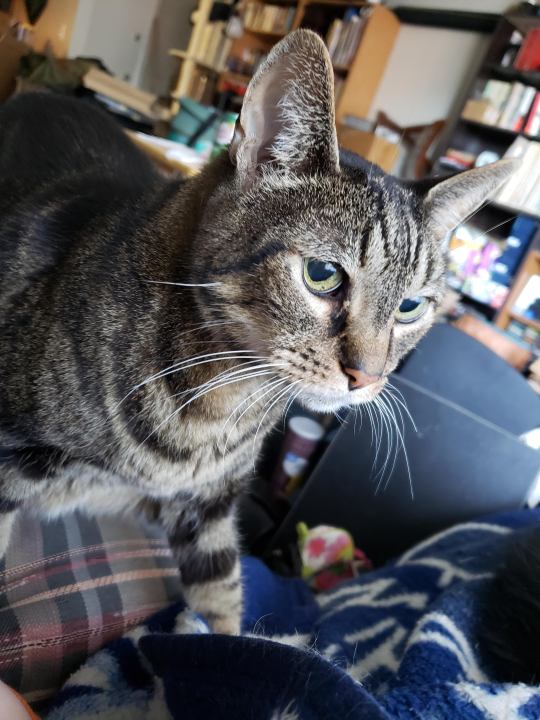
Look at that kitty face. That's my boy, Thor. In the fall of 2004, we adopted a litter of three 6-week old Halloween kittens who has been wanted out of a storm drain by an autumn storm. Because they were Halloween storm kitties, we named them accordingly. I named Thor after the little grey kitten from Number The Stars. We named his sisters Gloomdrop and Zot (partially for the sound of electricity/lightning and partially because she was the spitting image of the kitten in the webcomic Queen of Wands.

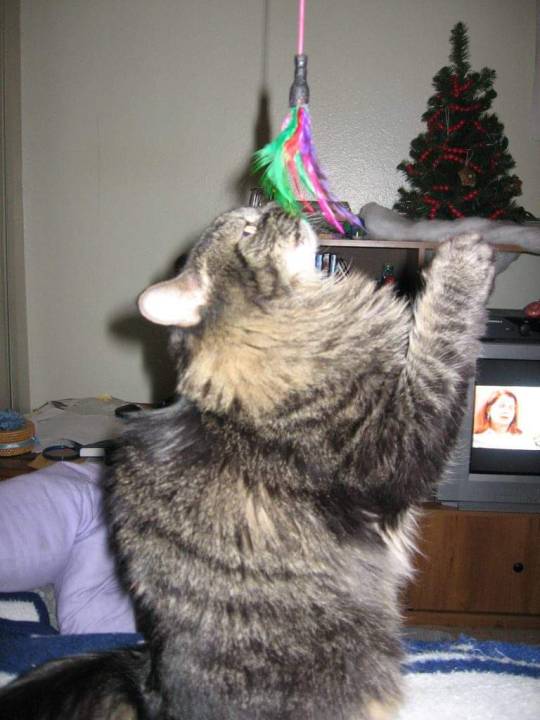

We lost Gloomdrop in February of 2019, and Zot is dealing with hind leg neuropathy as a side effect of her diabetes, but their brother, Thor, has always been the model of a healthy, active kitty.


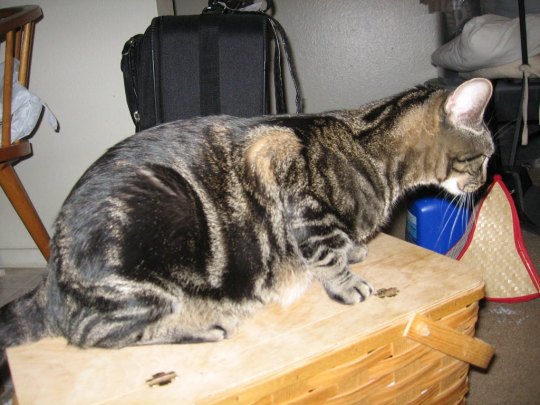
In mid-September (2020), Thor developed a lump in his hind right leg. After multiple tests, including 2 biopsies, our vet confirmed he had a malignant tumor and referred us to a specialist. We met with the oncologist today, and he diagnosed Thor with a soft tissue sarcoma, likely from his vaccines (a rare but documented side effect that occurs at the vaccine injection site.)


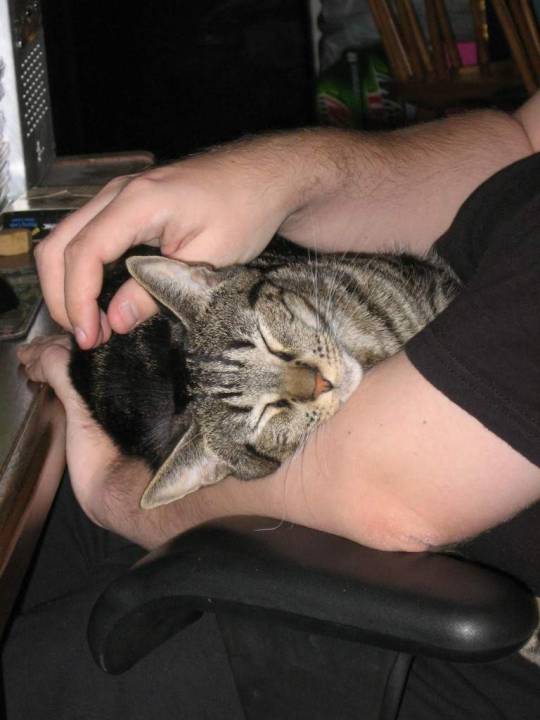
Happily, we caught the tumor early enough that it hasn't yet metastasized to the rest of his body. Less happily, Thor has two treatment options open to him: radiation or leg amputation. The vet confirmed that, other than this tumor, Thor is in incredible health -- not just for a 16-year-old kitty, but "even compared to cats half his age." Thor keeps up with -- and outpaces -- our 5-year-old cat, so that sounds pretty accurate to us!
Thor's radiation treatment is estimated at $3800, with another $1350 to cover the hospitalization that will go along with it since he'll be getting a sequence of five consecutive days at a hospital in Carlsbad. (He was a very good kitty on the 4-hr round trip commute there today for his consultation.) We have to wait ten days before doing the radiation, so his stitches from the punch biopsy can be removed, but the oncologist wants to stay the treatment as soon after that as possible.
Gloomdrop's end-of-life care and Zot's autoimmune, diabetes, and mobility care has already drained our savings, but we'll do everything we can for our kitties. While the oncologist thinks Thor might be able to adjust to being an amputee, even at 16, we are doing everything we can to try to make the radiation treatment feasible in order to preserve his quality of life.
Anything you can donate -- even just a dollar or sharing this -- would be amazing, and we would be so appreciative and ever grateful. We know right now is hard for so many people for so many reasons, and it means the world to us that you would even consider helping us save our kitty. We genuinely can't imagine what our lives would be like without our cuddly boy.
Thank you so much, especially if you read all of this! We love you, and Thor would, too, if he understood what was happening.
https://fundrazr.com/campaigns/01ir0c
37 notes
·
View notes
Text

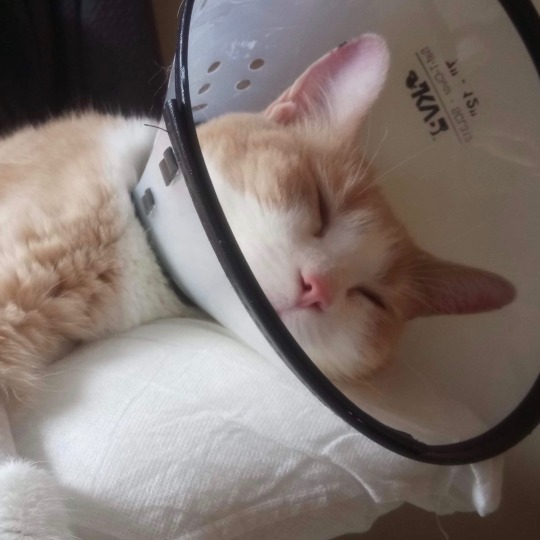
PLEASE READ‼️
my brother and his wife’s cat toby has been diagnosed with a very serious and rare form of cancer and will need upwards of $10,700 CAD to cover treatment. toby is a young cat with a ton of life left in him - it would be a complete and utter tragedy for his days to be cut short.
please consider donating here, and read below for more info on toby’s condition.
-
“At the beginning of the year Toby was diagnosed with cancer, specifically Injection-site Sarcoma (ISS), at only four years old. We learned without treatment my little boy would only have approximately one year left to live. ISS is a tumor caused by vaccines, injections and potentially genetics. Towards the end of 2019, we noticed a small lump on Toby's back and brought him to the vet. We were informed he would need a biopsy to identify it, which was about $800.00. As soon as we had the money we brought him in for his operation, and about an hour before I was allowed to pick him up I received a phone call from the vet technician. She called to let me know they had decided to do a lumpectomy since it had been larger than they had previously been able to see and it appeared to be more serious. Due to this, Toby's back had been almost entirely shaved and he had 25-30 stitches spanning the lower width. It hurt so much to see him like that, but he stayed strong and reminded us we needed to stay strong for him too. We spent every moment with Toby while he healed, constantly staying no further than a couple steps away. He healed so well, and had so much energy we began to feel relief and reassurance, until we received the phone call with his test results.
We were told Toby has cancer and was going to need extensive treatment in Guelph. This treatment will include: X-rays $200.00 Bloodwork $200.00 CT Scan $1,000.00 MRI $800.00 Chemotherapy & Radiation therapy $6,000.00 Follow up surgery $2,500.00
With the arrival of Covid-19, my workplace, as well as my husband's were shut down. I had no way to continue raising funds for his appointment due to bills needing to be paid. My workplace has been given the okay to re-open, however living on a single income still makes it hard to save. Any money I have leftover has been put into Toby's fund however, without receiving financial help, he might not even make it to his appointment. If you can spare any amount, Toby will be one step closer to his second chance at life. One that was jeopardized by the very vaccinations that were supposed to ensure he lived long and comfortably. Toby is fighting this with all of his strength, he just needs a helping hand. If you are able to donate even a little bit then you can help give Toby his Second Chance, so please donate today! #Toby'sSecondChance”
2 notes
·
View notes
Photo
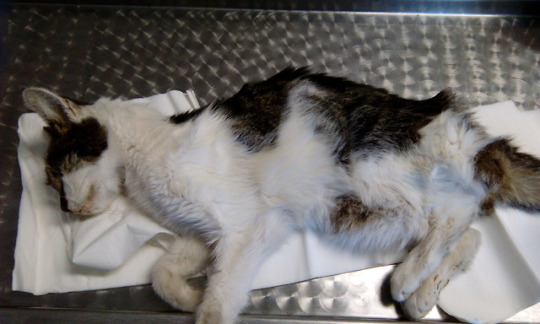

I will probably lose a lot of followers, and get anon hate again for posting something like this, but if seeing these photos will change someone’s mind about letting their cats roam freely, it is worth the effort.
Pictured above is a 4-year-old (!!!), unvaccinated, intact free-roaming female cat, which was presented for inappetence. When I asked the owners for how long she has been anorexic, they shrugged and said ‘a couple of days’, although I found it hard to believe, while examining the moribund cat on the table in front of me.
As you can notice, she is severely dehydrated, cachectic (loss of weight and muscle mass), anaemic and has a body condition score of 1. She also had purulent discharge coming from her eyes and nose, severe bronchitis, halitosis due to uraemia, stomatitis and lingual ulcers, diarrhoea.
She tested positive for Feline Leukaemia Virus(FeLV) and the lab results suggested acute kidney failure. Needless to say there was nothing I could do, except end her suffering.
FeLV is shed in the saliva and nasal secretions, urine, faeces and milk of the infected cats, and is spread especially through bite wounds, but also grooming, shared litter boxes and dishes, and from mother cats to their kittens either in utero or via nursing.
At my clinic, we call FeLV ‘the chameleon’, because it manifests through a multitude of symptoms that are actually caused by secondary diseases, not the virus itself. An infected cat may be asymptomatic for weeks, months or even years, but it keeps shedding the virus. FeLV causes blood disorders that lead to the deterioration, and thus, suppression of the immune system, so the cat acquires severe forms of diseases caused by bacteria, fungi, viruses or parasites that usually do not affect an otherwise healthy cat.
The sings of the disease are not very specific. Anorexia, anaemia, poor coat condition, fever, gingivitis, stomatitis, respiratory tract infections, diarrhoea, urinary infections, enlarged lymph nodes, abortion, eye diseases- these are the most commonly observed symptoms, a lot of which were present in the cat I examined.
ELISA and PCR are the most commonly used methods of testing.
At the moment, there is no definitive cure for FeLV, so the treatment is symptomatic. Antibiotics, blood transfusions and keeping the cats indoors is the mainstay of therapy.
I cannot stress this enough: KEEP CATS INDOORS.
All cats should be tested prior to introducing them to a multi-cat household.
FeLV, in itself, is NOT a death sentence. An infected cat can live a long a relatively normal life, although the median survival is 2,5 years, and that can be emotionally devastating for the owner. A FeLV positive cat should be closely monitored for any of the symptoms enumerated above and any suspicion should prompt a check-up at the vet.
Even though there has been some association between FeLV vaccine and injection site sarcomas in cats, the vaccine is rather safe and effective, although not 100%.
Preventing exposure is the most efficient way of protecting cats against FeLV. Same goes for FIV and FIP. Keep your cats indoors.
195 notes
·
View notes
Link
Vulvar Cancer report provides a detailed analysis of global market size, regional and country-level market size, segmentation, market growth, market share, and competitive landscape.
0 notes
Text
Chemotherapy Market at around USD 65,300 million and is expected to grow with the CAGR of 7.2% during forecast period

Chemotherapy is a type of cancer treatment that consists of the use of one or more chemotherapeutic agents including anti-cancer drugs. The increasing prevalence of cancer in the U. S. is propelling the growth of the market. For instance, according to the Centers for Disease Control and Prevention (CDC), around 650,000 cancer patients receive chemotherapy each year in United State.
According to the World Health Organization (WHO), approximately 17 million people are suffering from cancer across the globe. Chemotherapy kills the primary tumor of cancer instead of the shrinking the tumor. Thus, people prefer this treatment to treat cancer. Moreover, the technological advancement and rising emphasis on research and development in the field of oncology boosting the growth of the market.
Chemotherapy drugs can be injected directly into the bloodstream or can be targeted to exact cancer sites. However, this treatment has several side effects such as nausea & vomiting, alopecia, hair loss, fatigue, hearing impairment, mucositis, loss of appetite, and many more.
Grab a Free Sample PDF copy of the Chemotherapy Market Report 2019 @
https://straitsresearch.com/report/chemotherapy-market/request-sample
By Drug, Alkylating Agents, Mustard Gas Derivatives, Ethylenimines, Alkyl Sulfonates, Hydrazines, Triazines, Others, Antimetabolites, Anti-Tumor Antibiotics, Anthracyclines, Chromomycin, Topoisomerase Inhibitors, Topoisomerase I Inhibitors, Topoisomerase Ii Inhibitors, Mitotic Inhibitors, Others
By Indication, Leukemia, Lymphoma, Breast Cancer, Ovarian Cancer, Lung Cancer, Myeloma, Sarcoma, Others
By Route of Drug Administration, Oral, Intravenous
By End-User, Hospitals, Research Institutes, Others
Years that have been considered for the study of this report are as follows:
History Year: 2015-2018
Base Year: 2019
Estimated Year: 2019
Forecast Year: 2019 to 2026
View Full Report @ https://straitsresearch.com/report/chemotherapy-market/global/
Growing Domestic Demand and Expanding Pharmaceutical Sector to Drive the Demand for Chemotherapy in the APAC Region
Asia-Pacific region is anticipated to hold the largest market share in the global Chemotherapy market during the forecast period 2019-2026. The growth in this region can be attributed to the presence of emerging economies like India, China, Japan, Vietnam, and Indonesia, which account for the largest share in this region. India is one of the largest producers of Chemotherapy and a major exporter of the product to various countries across the globe. India accounts for around 80% of the world’s exports of Chemotherapy. The favorable climatic conditions and growth of agricultural inputs and allied services like cold storage and warehousing in India are prompting higher production.
Why buy this report right now?
Our report covers chemotherapy market insights, focusing on recent development in the market in different region and development strategies of the companies. Moreover, following sections are specifically covered in the report.
• Definitive Market Data
• cancer treatment market Analysis
• Competitive Analysis
• Recent Opportunities in the Market
• 6-7 year performance forecasts: major segments covering product type, cancer type, profiling technology, and application.
• Market Share Analysis
• Potential Venture Avenues
Buy Full Report with Detail Analysis with COVID-19 Impact @
https://straitsresearch.com/buy-now/chemotherapy-market/
The Major Players Covered in this Report: Sanofi, Novartis, Pfizer Inc., Eli Lilly & Company, ImClone Systems Inc., GlaxoSmithKline, AstraZeneca, Schering-Plough, Boehringer Ingelheim, Bristol-Myers Squibb, Teva Pharmaceuticals Industries, F. Hoffmann-La Roche Ltd, Merck & Co., Inc., Chemo Espana SL, CELGENE CORPORATION, Amgen Inc, Bayer AG, Takeda Pharmaceutical Company Limited, and others., & More...
Trending Reports of Straits Research –
Hepatitis B Therapeutics Market: Information by Therapy, Product Type (Hepatitis B Vaccine and Anti-viral Drugs), Distribution Channel and Regional Outlook - Forecast Till 2026
https://straitsresearch.com/report/hepatitis-b-therapeutics-market/
Stomach Cancer Market: Information by Therapy (Chemotherapy, Surgery), End-User (Hospitals & Clinics, Cancer Research, and Treatment Centers, and Diagnostic Centers)—Forecast Till 2026
https://straitsresearch.com/report/stomach-cancer-market/
Prostate Cancer Therapeutics Market: Information by Type of Therapy (Hormonal Therapy), Distribution Channel (Hospital Pharmacies, Online Sales), and Region — Forecast till 2029
https://straitsresearch.com/report/prostate-cancer-therapeutics-market/
Tissue Expander Market: Information by Application (Breast Reconstruction, Forehead Skin and Scalp Reconstruction, Face & Neck Reconstruction, Others), - Regional Forecast Till 2026
https://straitsresearch.com/report/tissue-expander-market/
Pemetrexed Market: Information by Application (Malignant Pleural Mesothelioma and Non-Squamous NSCLC) End User (Hospitals, Oncology Centers, Pharmacies) Regional Outlook — Forecast Till 2026
https://straitsresearch.com/report/pemetrexed-market/
For more details, please contact us -
Straits Research
Email: [email protected]
Address: 825 3rd Avenue, New York, NY 10022
Tel: +1 646 480 7505, +44 208 068 9665
Website: https://straitsresearch.com/
About Us:
Regardless of whether you're looking at business sectors in the next town or crosswise over continents, we understand the significance of being acquainted with what customers purchase. We overcome the issues of our customers by recognizing and deciphering just the target group, while simultaneously generating leads with the highest precision. We seek to collaborate with our customers to deliver a broad spectrum of results through a blend of market and business research approaches.
#Chemotherapy Market#healthcare#medical devices#pharma#market share#market research#straitsresearch#market researchreport
0 notes
Note
I HOPE YOUR DAUGHTER IS OK SYR also i smooch
I smooch back
Eclair issssss fine, hopefully. We don’t really know yet, it’s too early to tell. She developed a weird lump in her neck post-vaccination, which we’re monitoring -- there’s a low possibility that it might be injection site sarcoma, an aggressive fast-moving cancer that shows up in cats in response to receiving an injection. There’s a much higher possibility that it’s just inflammation, which is much easier to treat.
11 notes
·
View notes
Text
Pet Vaccination Kingston - Rabies Vaccination Required for All Cats
Rabies is a zoonotic disease, which means it can spread from animals to individuals and is lethal. New laws mean to secure cats just as the general society in Kingston.
At Grah Kingston, we are providing quality Pet Vaccination Service. We are known as one of the best Animal Vaccines vet clinics in Kingston open 7 days a week.
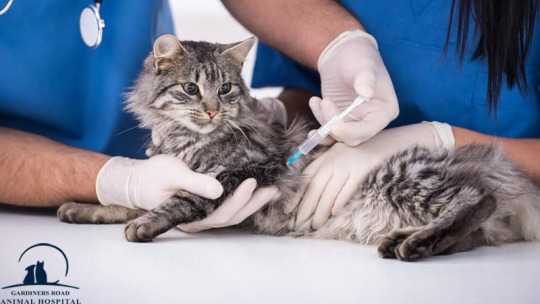
Are any cats excluded from rabies vaccination?
Indeed. Wild cats are excluded. Nonetheless, if wild cats are introduced to a veterinarian for sanitization, they should be vaccinated. The individual introducing the wild cat to the veterinarian is liable for taking care of the expense of rabies vaccination, as indicated by the new law. Cats more youthful than 4 months old enough are additionally absolved.
Do cat owners need to enroll their pets with their neighborhood region animal control office?
Indeed. All cat owners will be given a numbered restraint tag after vaccination (like the canine labels). Kindly check with your nearby district animal control for expenses and systems.
I just received a cat. Pet vaccination needed?
On the off chance that the cat is under 3 months old enough, he isn't qualified for vaccination. In any case, cats can be vaccinated as right on time as 3 months old enough and are needed to be vaccinated once he turns 4 months.
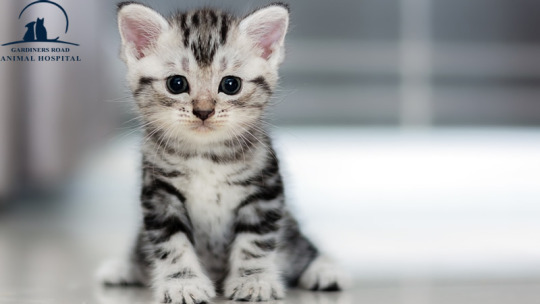
Is a "sponsor" shot required?
Indeed. All cats should get a second rabies vaccination within one year of the first. Converse with your nearby veterinarian about fitting planning spans between vaccinations.
My cat lives inside. Do I have to vaccinate her against rabies?
Totally. Rabies is a lethal disease on the whole mammals, including people. The infection is as yet present in the populaces of wild animals. Since pets come in close contact with people, it is basic that all canines and cats be vaccinated against rabies to ensure the general population. Indoor cats every so often depart to the outside, where they might be nibbled by frenzied untamed life (in some cases unbeknownst to the proprietor). What's more, the other way around, out of control untamed life (like bats) may enter homes and nibble an indoor cat.
Is rabies still an issue in Kingston?
Indeed! The Ontario Department of Public Health recognized in any event 84 rabies-positive bats in the state in 2018. That number was up significantly contrasted and 2017 when just 58 crazy bats were recognized statewide.

Vaccinated pets help keep pet owners and the overall population safe – so help save a day-to-day existence and keep your pet vaccinated, as well!
I heard animal vaccines can cause cancer in cats?
Infusion site sarcomas were first recognized in the mid-1990s. From that point forward, we have a superior comprehension of this uncommon marvel and its heap causes, which incorporate infusions just as unfamiliar materials other than vaccines, like steroids, anti-infection agents, and stitch. Even though exploration is continuous, the reason is likely an expanded region of irritation at the infusion site.
Even though there is a little danger of disease, the advantages of ensuring your pet, and relatives, from this destructive infection exceed those dangers. The danger of a cat building up an infusion site sarcoma is little. Studies gauge the danger is 1 of every 1,000 to around 1 out of 10,000 cats vaccinated.
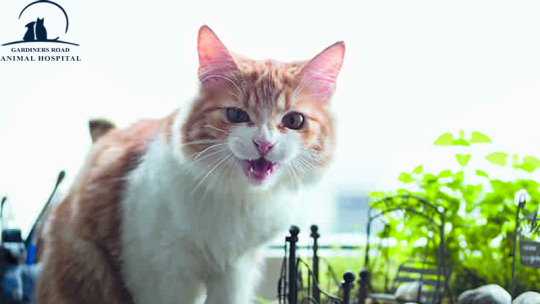
We suggest that you talk with your veterinarian at Animal Hospital in Kingston on the off chance that you are worried about vaccinations in your catlike pet. There are a few methods set up to moderate the danger to your pet while as yet managing the cost of the insurance from a dangerous infection, for example, utilizing non-adjuvanted vaccines and vaccinating just as now and again as vital (utilizing a 3-year vaccine versus a 1-year vaccine if accessible). Moreover, vaccinating distally on the appendages can make the treatment of malignancy more reasonable should it create.
At Animal Hospital in Kingston, our team of staff will be there to take care of your pet throughout all of its developmental stages. From routine pet vaccinations to pet emergency care services, we offer all of the services that your pet may need to remain healthy and happy. To schedule an exam at our vet clinic Kingston, give us a call at +1 613-634-(KVET)5838.
#AnimalHospitalInKingston#VetClinicKingston#PetVaccinationKingston#PetVaccinationServiceKingston#VaccinationServiceInKingston#AnimalVaccinesKingston#CatVaccineKingston#EmergencyPetServiceKingston#KingstonVet#VetsInKingston#24HourAnimalHospitalKingston
0 notes
Note
is the rabies vaccine given to cats the same one that they give to dogs? bc my local vet told me that she doesnt know much about cats and then gave my cat the same vaccine they give dogs, and then my cat had a severe reaction to it. she's never had a reaction to any vaccine before, but i know those can develop as they age so i dont want to just blame the vet if this is standard practice and i just never knew before
gettingvetted here.
Traditionally, dogs and cats have received the same rabies vaccine. Generally, most rabies vaccines are licensed for use in dogs, cats, and ferrets for 1 or 3 years at a time. Within the last 20 years, it has been discovered that cats can get a rare type of cancer at the site of killed vaccine injections (which would include rabies and leukemia vaccines), which is most likely due to the irritants (adjuvants) that are added to killed vaccines in order to better get the immune system’s attention. Therefore, newer killed vaccines use fewer adjuvants and the ones they do use are different, and at this time there are no documented instances of the cancer if a cat has only ever had the newer vaccines in its lifetime. Technically these new rabies vaccines can also be used on dogs, but they are more expensive than the standard rabies vaccine and dogs don’t really get that type of cancer, so most owners will opt for the less expensive, standard rabies vaccine.
63 notes
·
View notes
Note
I live in the US and work at a chain petstore in an area full of holistic, antivaxxers. I used to work at a vet clinic and these people drive me crazy. I just wanted some insight. Some lady told me the rabies vaccine gave her geriatric cat cancer. She said she'd never vaccinate again. I probably know the answer to this, but is it even possible for a vaccine to give cancer? I also told her good luck with the rabies.
Injection Site Sarcoma is the only recognized vaccine-associated cancer, and it is very rare. I have only seen one case in 8 years of practice, and that was as a referral center.
It is more strongly associated with rabies, FeLeuk and FIV vaccines than with others, possibly because of adjuvants rather than the viral particles themselves, but further research is certainly needed. There are various recommendations and guidelines about where to vaccinate, and when to vaccinate, and they should be followed to minimize any risks.
If she was complaining about her old cat getting, for example, lymphoma, the most common cancer of cats, then it’s most likely not related.
FeLeuk and FIV might be considered optional vaccines, but rabies is mandatory where the disease is endemic, so anyone not willing to vaccinate their dog or cat for rabies simply shouldn’t have one, and could perhaps consider a rabbit instead.
I’ve written a fair amount about injection site sarcoma if you are curious enough to check out the tag.
99 notes
·
View notes